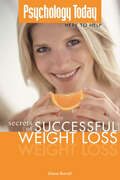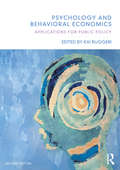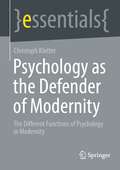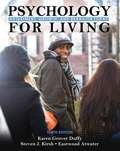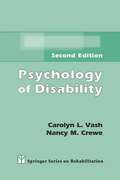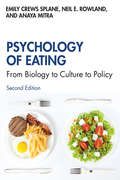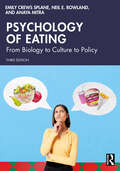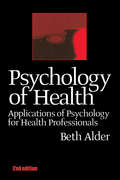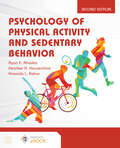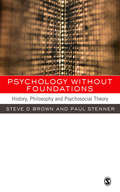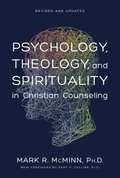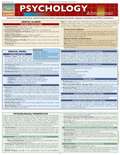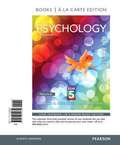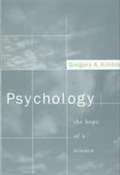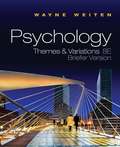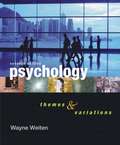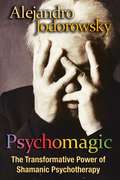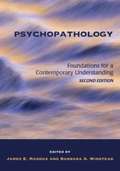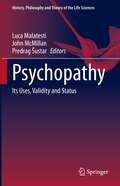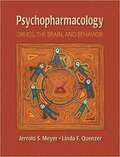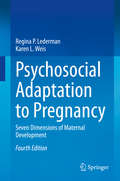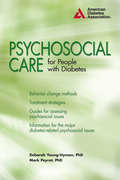- Table View
- List View
Psychology Today: Secrets of Successful Weight Loss
by Diana BurrellPsychology Today-changing the way readers think about losing weight. Written in the popular yet authoritative style of Psychology Today magazine, this groundbreaking book offers much more than a weight-loss program. It offers an understanding of the personal and social forces conspiring against healthy weight loss, conditions that make losing weight more difficult, an overview of every method-from Atkins to bariatric surgery-and sound advice on the importance of exercise and lifestyle changes.
Psychology and Behavioral Economics: Applications for Public Policy
by Kai RuggeriPsychology and Behavioral Economics offers an expert introduction to how psychology can be applied to a range of public policy areas. It examines the impact of psychological research for public policymaking in economic, financial, and consumer sectors; in education, healthcare, and the workplace; for energy and the environment; and in communications. Your energy bills show you how much you use compared to the average household in your area. Your doctor sends you a text message reminder when your appointment is coming up. Your bank gives you three choices for how much to pay off on your credit card each month. Wherever you look, there has been a rapid increase in the importance we place on understanding real human behaviors in everyday decisions, and these behavioral insights are now regularly used to influence everything from how companies recruit employees through to large-scale public policy and government regulation. But what is the actual evidence behind these tactics, and how did psychology become such a major player in economics? Answering these questions and more, this team of authors, working across both academia and government, present this fully revised and updated reworking of Behavioral Insights for Public Policy. This update covers everything from how policy was historically developed, to major research in human behavior and social psychology, to key moments that brought behavioral sciences to the forefront of public policy. Featuring over 100 empirical examples of how behavioral insights are being used to address some of the most critical challenges faced globally, the book covers key topics such as evidence-based policy, a brief history of behavioral and decision sciences, behavioral economics, and policy evaluation, all illustrated throughout with lively case studies. Including end-of-chapter questions, a glossary, and key concept boxes to aid retention, as well as a new chapter revealing the work of the Canadian government’s behavioral insights unit, this is the perfect textbook for students of psychology, economics, public health, education, and organizational sciences, as well as public policy professionals looking for fresh insight into the underlying theory and practical applications in a range of public policy areas.
Psychology and Life
by Philip G. ZimbardoThe classic text that defined the field, Psychology and Life, Fifteenth Edition, celebrates Phil Zimbardo's 30th anniversary as its author by returning to its original themes: presenting psychology as a science and as a tool to understanding our daily lives. The book continues to provide a rigorous, research-centered survey of the discipline while offering students features and pedagogy that will spark their interest and excite their imaginations.
Psychology and Your Life
by Robert S. FeldmanNo matter what brings students into the introductory course and regardless of their initial motivation, Psychology and Your Life is designed to draw students into the field by illustrating how psychology will affect them in their career--whether they are studying to become a medical assistant, a graphic designer, or a police officer, or any other program.
Psychology as the Defender of Modernity: The Different Functions of Psychology in Modernity (essentials)
by Christoph KlotterPeople in Germany have an indifferent to poor relationship with our society. In fact, modernity, i.e. the last 200 years, has given the population historically unprecedented progress: democracy, human rights, social security systems, nutritive abundance. Yet this is little appreciated. This may be due to the fact that, in Diderot's sense, we have to prove ourselves permanently, that is, we live in a meritocracy that produces suffering. However, totalitarian ideologies have also emerged and been implemented in modernity, for which modernity is also responsible. This essential shows that psychology, on closer inspection, turns out to be the defender of the good parts of modernity.
Psychology for Living: Adjustment, Growth, and Behavior Today (10th Edition)
by Steven J. Kirsh Eastwood Atwater Karen Grover DuffyPsychology For Living is intended for readers interested in applying psychological insights and principles to their own lives as a way of achieving a better understanding of themselves and of living more effectively. To this end, we have included material from the major perspectives of psychology, including the psychodynamic, cognitive-behavioral, and humanistic viewpoints. Since a well-rounded text cuts across several branches of psychology, we have included contributions from clinical, personality, social, and develop¬mental psychology, as well as from the important fields of cognitive, biological, and health psychology. Throughout the book, we've presented differing views on the same issue, along with questions that are designed to stimulate readers' critical thinking.
Psychology of Disability (2nd edition)
by Nancy M. Crewe Carolyn L. VashThe latest edition, 20 years after the first, incorporates the many changes that have occurred in disability-related language, legislation, technology, and research. Its two sections focus first on the disability experience a chronicle of what it's like to be disabled and how objective and subjective experiences affect the basic functions of living, working, and playing and then on interventions a response to the problems and sources of psychological pain exposed by the discussions in the first section. Vash (a writer and consulting psychologist in Altadena, Calif. ) and Crewe (Michigan State U. ) see their work as both a textbook or collateral reading source for those studying the psychological aspects of disability, and a general resource for rehabilitation professionals.
Psychology of Eating: From Biology to Culture to Policy
by Neil Rowland Emily Splane Anaya MitraThe Psychology of Eating is the essential multi-disciplinary introduction to the psychology of eating, looking at the biological, genetic, developmental, and social determinants of how humans find and assimilate food. Thoroughly revised and updated, the new edition brings multi-faceted expertise to the topic of normal and dysfunctional food intake, juxtaposing "normal" eating, eating in environments of food scarcity, and the phenomenon of "abnormal" eating prevalent in many modern-day developed societies. Eating disorders are not a focus, but also emerge from, this approach. Key features include: A new expanded section considering the roles of business and government in creating and potentially solving the issue of "abnormal" eating Learning objectives, talking points, and end-of-chapter glossaries Chapter-by-chapter self-assessment questions. With questions of food production, food choice, and environmental sustainability becoming more critical in an increasingly populated world, this is crucial reading for undergraduate courses in Psychology and other disciplines with a holistic and critical thinking approach to the psychology of food intake.
Psychology of Eating: From Biology to Culture to Policy
by Anaya Mitra Neil E. Rowland Emily Crews SplaneThe Psychology of Eating is the essential multidisciplinary introduction to the psychology of eating, looking at the biological, genetic, developmental, and social determinants of how humans find and assimilate food.Thoroughly revised and updated, this new, third edition brings multifaceted expertise to the topic of normal and dysfunctional food intake, juxtaposing ‘normal’ eating, eating in environments of food scarcity, and the phenomenon of ‘abnormal’ eating prevalent in many modern-day developed societies. The book includes some discussion of eating disorders but takes a much broader approach to the psychology of eating. Key updates in this edition include: A new discussion of food allergies. A fully updated chapter on eating disorders, which includes discussion of binge-eating. Greater focus on junk food addition and updated information on epigenetics and the microbiome Featuring student-friendly materials such as learning objectives, talking points, glossaries, and self-assessment questions, this book is essential reading for students of psychology, eating behavior, or health sciences. It will also be useful reading for professionals in health psychology and anyone supporting those with eating disorders and obesity.
Psychology of Health: Applications of Psychology for Health Professionals
by Beth AlderFirst published in 1999. Now this popular textbook has been substantially revised and updated to include: Cutting edge research and data; Twelve chapters - ideal for term/semester teaching; Summaries of psychology theory, clearly explained; Involving and thought-provoking activities and projects; Awareness of the treatment of illness and health issues; Exercises which improve the student's therapeutic skills, making it easier to cope with professional demands and personal pressures. Psychology of Health is aimed at health professional students. Students with no prior experience in the subject will gain valuable knowledge. Relevant courses include nursing, physiotherapy. occupational therapy. speech therapy. podiatry and dietetics.
Psychology of Physical Activity and Sedentary Behavior
by Ryan E. Rhodes Heather A. Hausenblas Amanda L. RebarWritten for the upper-level undergraduate and graduate-level courses in exercise psychology and behavioral physical activity, Psychology of Physical Activity and Sedentary Behavior, Second Edition focuses on the psychological effects of physical activity in a diverse array of populations. It emphasizes how physical activity needs to be paired with a reduction in sedentary behavior in order to achieve overall health. With a focus on both the psychology of exercise and sedentary behavior, this first-of-its kind text provides readers with the latest research in both areas, including coverage of sleep, pain, and delayed gratification. This text also applies a critical lens to foundational theories and incorporates applications and interventions throughout.
Psychology without Foundations: History, Philosophy and Psychosocial Theory
by Steven Brown Paul StennerFor many years, for many people social psychology has been deemed a discipline in crisis.<P><P> This new book proposes a way out of the crisis by letting go of the idea that psychology needs new foundations or a new identity, whether biological, discursive or cognitive. The psychological is not narrowly confined to any one aspect of human experience; it is quite literally everywhere. <P> The book proposes a strong process-oriented approach to the psychological, which studies events or occasions. Aspects of experience such as communication or embodiment are treated as thoroughly mediated - the product of multiple intersecting relationships between the biological, the psychic and the social. The outcome is an image of a mobile, reflexively founded discipline which follows the psychological wherever it takes us, from the depths of embodiment to the complexities of modern global politics.
Psychology, Theology, and Spirituality in Christian Counseling
by Mark R. McminnThis book points counselors to ways they can integrate biblical principles into their counseling techniques.
Psychology: Abnormal
by Albert E. LyngzeidetsonPsychology students and those already practicing in the field will want to obtain this jam-packed, 3-panel (6 page) expanded version of BarCharts popular Psychology: Abnormal guide. The new information, along with the original guide text, lists a variety of mental disorders and the therapies used to treat them; each color-coded section features key definitions and examples for easy reference.
Psychology: An Exploration with DSM5 Update
by J. Noland White Saundra CiccarelliUsing the most recent recommended APA undergraduate psychology learning outcomes, the authors establish clear learning objectives for students that are tied to these objectives. Student and instructors praise Ciccarelli and White's approach to teaching and learning in today's classroom. The thirteen-chapter table of contents covers the essentials that every introductory psychology student should know and fits easily into a one-semester course.
Psychology: In Search of the Human Mind (4th Edition)
by Robert J. SternbergSternberg (psychology, Yale University) emphasizes the theme of unity in psychological sciences in this fourth edition. This edition has been edited for readability and interest, and includes new boxed features on how psychologists from different disciplines would treat the same condition. Also new are expanded quizzes, critical thinking questions, and chapter summaries. The CD- ROM contains animations, activities, and videos. Annotation (c)2003 Book News, Inc., Portland, OR (booknews.com)
Psychology: The Hope of a Science
by Gregory A. KimbleAt a time in the history of psychology when many psychologists are troubled by the splintered condition of the field, Gregory Kimble proposes that the diverse perspectives in psychology share ways of thinking that can bring coherence to the discipline.
Psychology: Themes and Variations (8th Edition)
by Wayne WeitenIn PSYCHOLOGY: THEMES AND VARIATIONS, BRIEFER VERSION, Wayne Weiten continues his proven combination of a scientifically rigorous text with selective pedagogy that makes learning easy for students. Weiten's approach is backed by a straightforward writing style, unparalleled in-text visuals and didactic art program, and in-book review to help users prioritize and retain the core concepts. Weiten surveys psychology's broad range of content with three aims: to illuminate the process of research and its intrinsic relationship to application (themes); to show both the unity and diversity of the subject (variations), and to invite users to the study of psychology by respecting their ability to master its fundamental concepts. Weiten's themes (including empiricism, theoretical diversity, sociohistorical contexts, multifactorial causation, cultural heritage, heredity and environment, and subjectivity of experience) and variations provide unifying threads across chapters that help users see the connections among different research areas in psychology.
Psychology: Themes and Variations (Seventh Edition)
by Wayne WeitenThe Seventh Edition of Wayne Weiten's popular text, Psychology: Themes and Variations, continues to offer students a unique survey of psychology with three distinct goals: to show both the unity and diversity of psychology's subject matter; to illuminate the process of research and its intimate link to application, and to make the text challenging to think about and easy to learn from.
Psychomagic: The Transformative Power of Shamanic Psychotherapy
by Alejandro JodorowskyA healing path using the power of dreams, theater, poetry, and shamanism • Shows how psychological realizations can cause true transformation when manifested by concrete poetic acts • Includes many examples of the surreal but successful actions Jodorowsky has prescribed to those seeking his help While living in Mexico, Alejandro Jodorowsky became familiar with the colorful and effective cures provided by folk healers. He realized that it is easier for the unconscious to understand the language of dreams than that of rationality. Illness can even be seen as a physical dream that reveals unresolved emotional and psychological problems. Psychomagic presents the shamanic and genealogical principles Jodorowsky discovered to create a healing therapy that could use the powers of dreams, art, and theater to empower individuals to heal wounds that in some cases had traveled through generations. The concrete and often surreal poetic actions Jodorowsky employs are part of an elaborate strategy intended to break apart the dysfunctional persona with whom the patient identifies in order to connect with a deeper self. That is when true transformation can manifest. For a young man who complained that he lived only in his head and was unable to grab hold of reality and advance toward the financial autonomy he desired, Jodorowsky gave the prescription to paste two gold coins to the soles of his shoes so that all day he would be walking on gold. A judge whose vanity was ruling his every move was given the task of dressing like a tramp and begging outside one of the fashionable restaurants he loved to frequent while pulling glass doll eyes out of his pockets. The lesson for him was that if a tramp can fill his pockets with eyeballs, then they must be of no value, and thus the eyes of others should have no bearing on who you are and what you do. Taking his patients directly at their words, Jodorowsky takes the same elements associated with a negative emotional charge and recasts them in an action that will make them positive and enable them to pay the psychological debts hindering their lives.
Psychopathology: Foundations for a Contemporary Understanding (2nd Edition)
by Barbara A. Winstead James E. MadduxPsychopathology is intended for first-year graduate students in clinical psychology, counseling psychology, and related fields, and it has been specifically designed to meet the needs of students in these courses. Maddux and Winstead have brought together the most distinguished researchers in the fields of clinical psychology and psychopathology in order to provide up-to-date information about theory and research, as well as to challenge students to think critically about psychopathology. Thoroughly revised and updated from the previous edition, the book focuses throughout on what has been demonstrated by research, not on what has been claimed by theories that may be accepted or traditional but lack empirical support. The first section presents and analyzes the basic concepts we need to understand any disorder; the second examines the disorders most frequently encountered in clinical practice.
Psychopathy: Its Uses, Validity and Status (History, Philosophy and Theory of the Life Sciences #27)
by John McMillan Luca Malatesti Predrag ŠustarThis book explains the ethical and conceptual tensions in the use of psychopathy in different countries, including America, Canada, the UK, Croatia, Australia, and New Zealand. It offers an extensive critical analysis of how psychopathy functions within institutional and social contexts. Inside, readers will find innovative interdisciplinary analysis, written by leading international experts. The chapters explore how different countries have used this diagnosis. A central concern is whether psychopathy is a mental disorder, and this has a bearing upon whether it should be used. The book’s case studies will help readers understand the problems associated with psychopathy. Academics and students working in the philosophy of psychiatry, bioethics, and moral psychology will find it a valuable resource. In addition, it will also appeal to mental health professionals working in forensic settings, psychologists with an interest in the ethical implications of the use of psychopathy as a construct and particularly those with a research interest in it.
Psychopharmacology: Drugs, the Brain, and Behaviors (2nd Edition)
by Richard A. Harvey Michelle A. Clark Richard Finkel Jose A. Rey Karen WhalenRecent advances in molecular pharmacology and brain imaging have revolutionized our understanding of how psychoactive drugs work. Now, from the authors of Principles of Neuropsychopharmacology, comes a new undergraduate textbook integrating these developments. The first section of the book provides extensive foundation materials, including the basic principles of pharmacology, neurophysiology and neuroanatomy, synaptic transmission, and methods in psychopharmacology. The second section describes key features of major neurotransmitter systems, including the catecholamines, serotonin, acetylcholine, glutamate and GABA. The third and fourth sections discuss theories and mechanisms of drug addiction and psychopathology. All major substances of abuse as well as drugs used to treat mental illness are covered. Psychopharmacology: Drugs, the Brain and Behavior is unique in its breadth of coverage, ranging from historical accounts of drug use to clinical and preclinical behavioral studies to the latest research on drug effects in transgenic mouse models. Student engagement with the material is fostered by opening each chapter with a relevant vignette and by providing breakout boxes presenting novel or cutting-edge topics for special discussion. The book is extensively illustrated with full-color photographs and line art depicting important concepts and experimental data. Psychopharmacology: Drugs, the Brain and Behavior is appropriate for undergraduate psychopharmacology or drugs and behavior courses that emphasize relationships between the behavioral effects of psychoactive drugs and their mechanisms of action.
Psychosocial Adaptation to Pregnancy: Seven Dimensions of Maternal Development
by Regina P. Lederman Karen L. WeisThe fourth edition of this book updates and elaborates on the seven dimensions of maternal emotional health that have significant impact on delivery, postpartum adaptation, infant health, and early childhood development. Supported by the authors’ original research and interviews, the book provides readers with an analysis of the role of these core functions throughout pregnancy, as well as practical materials for use with pregnant clients in the form of assessment instruments and evidence-based interventions for promoting positive development. The book provides a theoretical framework with rationales for the seven psychosocial dimensions, therapeutic and counseling intervention strategies to improve adaptive development in each of the seven psychosocial dimensions, findings specific to women in diverse cultural groups, a chapter devoted to women in the military and military spouses, and discussion of salient issues of pregnancy, including physical changes, body image, intimacy, trust, and ambivalence.The book focuses on the seven dimensions of maternal prenatal emotional health:Acceptance of the pregnancy.Motivation and preparation for motherhood.Relationship with husband/partner.Relationship with her own mother. Preparation for labor.Sense of control in laborSelf-Esteem and Well-Being in labor. Psychosocial Adaptation to Pregnancy is a significant addition to the psychosocial assessment literature, a needed resource for clinical and health psychologists, clinical social workers, marriage and family therapists, professional counselors, midwives, and obstetrical nurses. It is also adaptable to undergraduate and graduate courses in maternal reproductive health and obstetrical nursing.
Psychosocial Care for People with Diabetes
by Mark Peyrot Deborah Young-HymanPsychosocial Care for People with Diabetes describes the major psychosocial issues which impact living with and self-management of diabetes and its related diseases, and provides treatment recommendations based on proven interventions and expert opinion. The book is comprehensive and provides the practitioner with guidelines to access and prescribe treatment for psychosocial problems commonly associated with living with diabetes.
